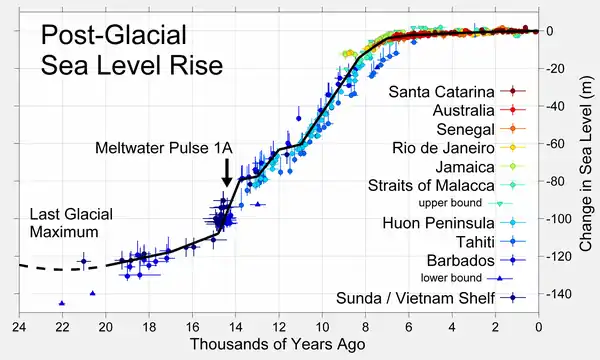Early Holocene sea level rise
The early Holocene sea level rise (EHSLR) was a significant jump in sea level by about 60 m during the early Holocene, between about 12,000 and 7,000 years ago, spanning the Eurasian Mesolithic.[1] The rapid rise in sea level and associated climate change, notably the 8.2 ka cooling event (8,200 years ago), and the loss of coastal land favoured by early farmers, may have contributed to the spread of the Neolithic to Europe.[2]


During deglaciation since the Last Glacial Maximum, between about 20,000 to 7,000 years ago (20–7 ka), the sea level rose by a total of about 100 m, at times at extremely high rates, due to the rapid melting of the British-Irish Sea, Fennoscandian, Laurentide, Barents-Kara, Patagonian, Innuitian and parts of the Antarctic ice sheets. At the onset of deglaciation about 19,000 years ago, a brief, at most 500-year long, glacio-eustatic event may have contributed as much as 10 m to sea level with an average rate of about 20 mm/yr. During the rest of the early Holocene, the rate of sea level rise varied from a low of about 6.0–9.9 mm/yr to as high as 30–60 mm/yr during brief periods of accelerated sea level rise.[3][4]
Solid geological evidence, based largely upon analysis of deep cores of coral reefs, exists only for three major periods of accelerated sea level rise, called meltwater pulses, during the last deglaciation. The first, Meltwater pulse 1A, lasted between c. 14.6–14.3 ka, a 13.5 m rise over about 290 years centered at 14.2 ka.
The EHSLR spans Meltwater pulses 1B and 1C, between 12,000 and 7,000 years ago:
- Meltwater pulse 1B between c. 11.4–11.1 ka, a 7.5 m rise over about 160 years centered at 11.1 ka, which includes the Younger Dryas interval of reduced sea level rise at about 6.0–9.9 mm/yr;
- Meltwater pulse 1C between c. 8.2–7.6 ka, centered at 8.0 ka, a rise of 6.5 m in less than 140 years.[4][5][6]
Such rapid rates of sea level rising during meltwater events clearly implicate major ice-loss events related to ice sheet collapse. The primary source may have been meltwater from the Antarctic ice sheet. Other studies suggest a Northern Hemisphere source for the meltwater in the Laurentide Ice Sheet.[6]
See also
- Last Glacial Maximum – Most recent glacial maximum during the Last Glacial Period that ice sheets were at their greatest extent
- Next Glacial Maximum
- Past sea level – Sea level variations over geological time scales
- Holocene glacial retreat – Global deglaciation
- Holocene climatic optimum – A warm period during roughly the interval 9,000 to 5,000 years BP
- 8.2 kiloyear event
- Younger Dryas – Time period
- Doggerland – Land mass now beneath the southern North Sea that connected Britain to mainland Europe
- Pre-Pottery Neolithic A
- Pre-Pottery Neolithic B – Archaeological culture
References
- D.E.Smith, S.Harrison, C.R.Firth, J.T.Jordan, "The early Holocene sea level rise", Quaternary Science Reviews, Volume 30, Issues 15–16, July 2011, Pages 1846-1860. "The rise, of ca 60m, took place over most of the Earth as the volume of the oceans increased during deglaciation and is dated at 11,650–7000 cal. BP. The EHSLR was largely driven by meltwater release from decaying ice masses and the break up of coastal ice streams. [...] The impact of the EHSLR on climate is reviewed and it is maintained that the event was a factor in the 8200 BP cooling event, as well as in changes in ocean current patterns and their resultant effects. The EHSLR may also have enhanced volcanic activity, but no clear evidence of a causal link with submarine sliding on continental slopes and shelves can yet be demonstrated. The rise probably influenced rates and patterns of human migrations and cultural changes."
- Chris S.M.Turney, Heidi Brown, "Catastrophic early Holocene sea level rise, human migration and the Neolithic transition in Europe", Quaternary Science Reviews, Volume 26, Issues 17–18, September 2007, Pages 2036-2041.
- Cronin, T. M. (2012) Invited review: Rapid sea-level rise. Quaternary Science Reviews. 56:11-30.
- Blanchon, P. (2011a) Meltwater Pulses. In: Hopley, D. (Ed), Encyclopedia of Modern Coral Reefs: Structure, form and process. Springer-Verlag Earth Science Series, p. 683-690. ISBN 978-90-481-2638-5
- Blanchon, P. (2011b) Backstepping. In: Hopley, D. (Ed), Encyclopedia of Modern Coral Reefs: Structure, form and process. Springer-Verlag Earth Science Series, p. 77-84. ISBN 978-90-481-2638-5
- Blanchon, P., and Shaw, J. (1995) Reef drowning during the last deglaciation: evidence for catastrophic sea-level rise and icesheet collapse. Geology, 23:4–8.
- Torbjörn E. Törnqvist, Marc P. Hijma, "Links between early Holocene ice-sheet decay, sea-level rise and abrupt climate change", Nature Geoscience vol. 5 (2012), 601–606.
- T. M. Cronin P. R. Vogt D. A. Willard R. Thunell J. Halka M. Berke J. Pohlman, "Rapid sea level rise and ice sheet response to 8,200‐year climate event", Geophysical Research Letters vol. 34, issue 20 (October 2007), doi:10.1029/2007GL031318.
- Kazuaki Hori Yoshiki Saito, "An early Holocene sea‐level jump and delta initiation", Geophysical Research Letters vol. 34, issue 18 (September 2007), doi:10.1029/2007GL031029.
- Shi-Yong Yu, Y.-X. Li and T.E. Törnqvist, "Tempo of global deglaciation during the early Holocene: A sea level perspective", PAGES News vol. 17, no. 2 (June 2009), doi:10.1038/NGEO470.
